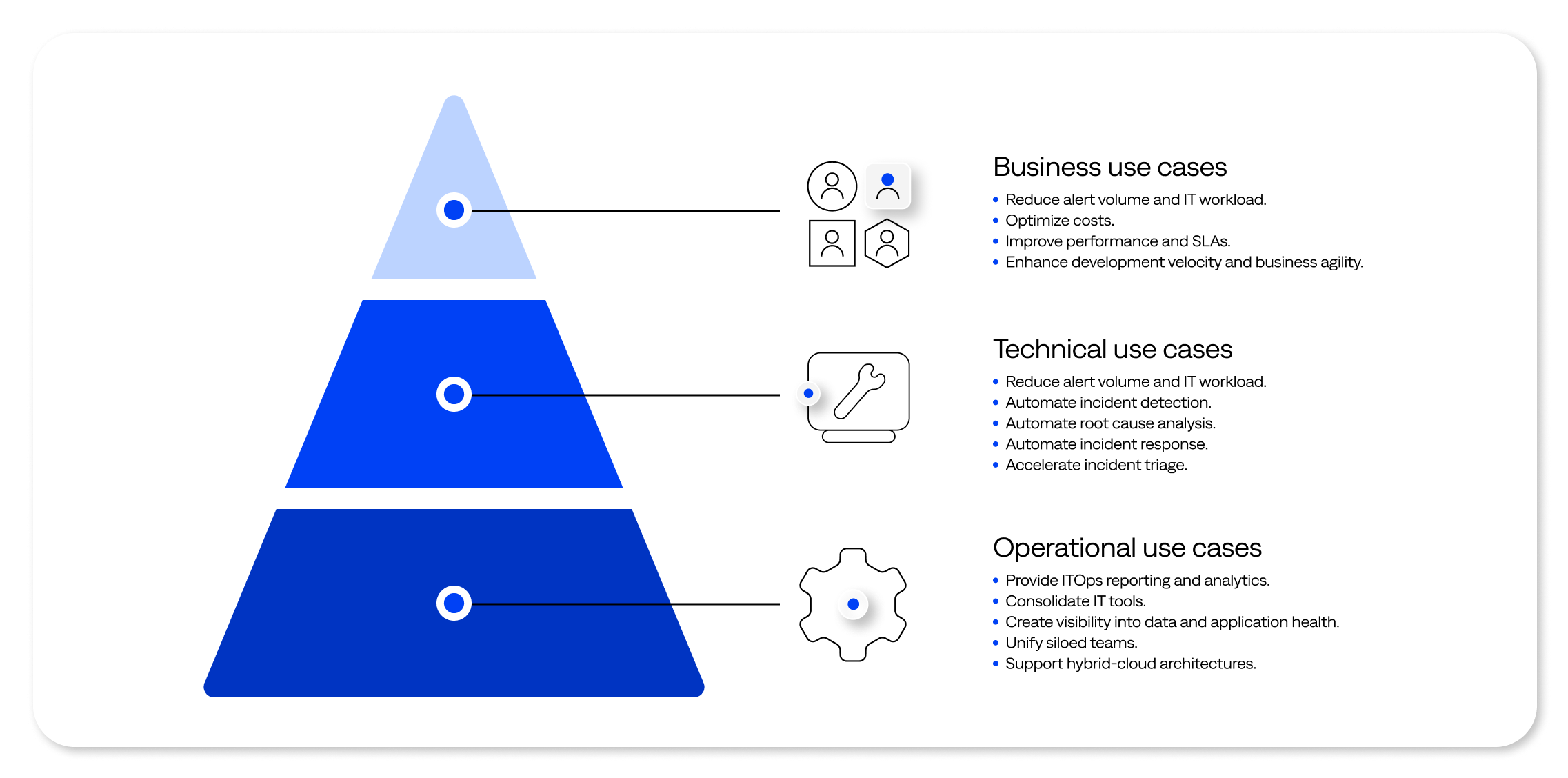1
Why AIOps for ITOps?
ITOps stands at a crossroads: Teams need help managing high volumes of alerts and coordinating between different tools and teams. They must balance the agility offered by cloud technologies and the stability provided by on-premises solutions.
Success relies heavily on adaptability and clarity, requiring flexibility, with synchronized technology stacks for seamless IT operations.
AIOps, a term coined by Gartner, provides a straightforward way to improve IT operations by:
- Reducing alert noise
- Automating incident response
- Integrating tools
- Helping teams collaborate
- Unifying cloud and on-premises systems
By understanding the many AIOps use cases across technical, operational, and business processes, you’ll discover ways to filter out false alarms intelligently, boost operational efficiency, and prioritize events based on potential business impact. ITOps, DevOps, and site-reliability engineering (SRE) teams leverage AIOps for accelerated and more impactful IT performance.
2
How AIOps helps IT teams
AIOps benefits IT teams in a variety of ways, including:
- Efficiency through automation: AIOps streamlines IT tasks, automating processes like event correlation and incident resolution. Team members have more time to concentrate on strategic initiatives, enhancing efficiency and collaboration.
- Empowerment with real-time insights: AIOps equips teams with instant visibility into IT systems, enabling them to identify anomalies and trends before they impact end users. This proactive approach minimizes downtime and accelerates incident resolution.
- Reliability using advanced analytics: By harnessing predictive analytics, teams can anticipate and address potential issues before they occur. Maintaining system reliability and optimizing resource allocation fosters a forward-thinking and proactive problem-solving team culture.
- Growth with scalability and adaptability: AIOps tools adapt seamlessly as IT environments evolve, scaling to meet increasing demands. This flexibility allows teams to focus on innovation rather than being bogged down by infrastructure constraints.
3
Top AIOps use cases
AIOps use cases fall into three primary categories: business, technical, and operational. These use cases involve many stakeholders, from frontline response teams to CEOs. However, the impact is most strategic for business and operational use cases.
Business use cases focus on strategies to improve service availability, develop agility, and optimize the IT function to gain operational efficiencies and enhance development speed. Operational use cases involve unifying siloed teams, tools, and cloud architecture.
4
How AIOps benefits different tech roles
AIOps can benefit any technology framework, including DevOps, IT service management (ITSM), and SRE.
- AIOps and DevOps: DevOps focuses on making application delivery more efficient while unifying development and ITOps stakeholders. Automation plays a significant role in DevOps, often through CI/CD pipelines. AIOps accelerates development, enhances collaboration, and improves system health. Using AIOps for event correlation also helps DevOps teams detect anomalies and repair issues before they affect users.
- AIOps and ITSM: ITSM is the traditional method of IT management using ITIL best practices. The system administrator plays the central role. AIOps speeds up the triage and resolution of IT issues under ITSM.
- AIOps and SRE: SRE teams focus on system health and maximizing uptime. Automation is also essential to eliminating repetitive work, standardizing processes, and breaking operational or data silos. AIOps supports SREs by simplifying the prevention of system degradation.
5
Top AIOps use cases for business benefits
Business use cases focus on improving specific business outcomes. AIOps is a strategic lever that can help you navigate IT challenges more effectively.
Four AIOps use cases for business teams include reducing alert volume and IT workload, optimizing costs, improving system performance and SLA alignment, enhance development speed and business agility.
Reduce alert volume and IT workload
Event correlation and automated response reduce workload for ITOps teams. Using alert intelligence to reduce alert volume by more than 90%, AIOps helps organizations scale their ability to manage growth in data, scale, and incident volumes. In addition, also AIOps reduces alert volume and workloads in the following ways:
- Automation: Workflow automation streamlines incident management to enhance scalability and efficiency. By providing business context while automating ticketing, notifications, and custom workflows, AIOps aids early incident detection, helping to prevent costly SLA breaches.
- Level 1 resolution: Enriched incident data enables Level One (L1) engineers to handle more issues independently, minimizing the need for high-cost teams and allowing specialists to focus on critical projects.
- Analytics: Productivity analytics enable NOC directors and managers to track team, site, and shift performance, identifying opportunities for best-practice sharing, process optimization, and improved team scheduling.
Optimize IT spending
Resource consumption can easily get out of control with the increasing adoption of application services. AIOps gives you control and visibility over your IT resources while clarifying which of your monitoring tools are necessary for incident management. This insight lets you cut redundant tools and services to optimize IT spending while meeting your operational needs.
Improve performance and SLAs
IT infrastructure is a crucial business enabler. Profitability and customer satisfaction depend on strong technology performance. ITOps leaders must ensure service availability, system performance, and positive customer experiences by keeping revenue-generating services operating.
AIOps tools can improve service availability, reducing mean time to resolution (MTTR) by more than 50% and helping to meet performance objectives. AIOps swiftly identifies and addresses incident root causes, improves user experience, and ensures timely system restoration, all while optimizing legacy tool management and ensuring SLA compliance. These capabilities support faster incident resolution, reduced outages, and improved system performance and customer transaction continuity.
Enhance development velocity and business agility
Organizations working toward digital transformation often need help with alert overload, slow incident management, and bottlenecks. AIOps automates workflows and root-cause analysis, empowers L1 engineers, and frees L3 and DevOps teams to focus on innovation.
AIOps also aligns with modern architecture and hybrid environments — vital for initiatives like microservices and containerization — addressing challenges posed by traditional incident management tools in cloud and hybrid settings.
6
AIOps use cases for technical teams
Technical use cases range from addressing the daily alert flow to automating incident response. These use cases prioritize, detect, and remedy issues to ensure that networks, hardware, and applications run smoothly.
Five technical AIOps use cases include reducing alert fatigue and workload for IT teams, automating incident detection, automating root-cause analysis, automating incident response, and accelerating incident triage.
Reduce alert volume and IT workload
Today’s complex computing environments have led organizations to deploy long lists of monitoring tools, with large organizations using more than 20 to oversee critical applications and resources. The surge in these tools leads to an overwhelming volume of alerts, challenging ITOps, network operations center (NOC), DevOps, and SRE teams to isolate critical issues.
Traditional attempts to solve this problem include filtering only high-severity alerts, adding staff, or relying on customers to report issues so IT can react. However, an AIOps platform allows teams to process large amounts of event data in real time, analyze it, and detect meaningful insights.
AIOps platforms can automate creating tickets, sending notifications, convening team members, initiating workflows, and triaging incidents. They reduce IT workload and correlate alerts to a single cause, with top-tier AIOps platforms helping companies like Autodesk reduce IT disturbances by up to 95%.
Automate incident detection
As the AI learns from the IT environment, AIOps platforms can automate incident detection. Most teams have fragmented tools that lack integration and have visibility into only part of the IT stack. This siloed monitoring of big data makes it hard to obtain cross-stack insights.
Advanced AIOps platforms connect these tools, combining the data in real-time. A unified view enables the enrichment of alert monitoring with context from other data sources, providing greater visibility into the scope and root causes of incidents and outages. Additionally, AIOps can flag security threats and other issues related to regulatory compliance.
Automate root-cause analysis
The best AIOps platforms automate event investigation. They use AI and ML to analyze system changes, topology, and incident timelines. Rapid infrastructure changes, especially within cloud architectures, often lead to incidents.
Change management tools don’t track many of these shifts, making it hard to know which change to blame. AIOps platforms integrate vast amounts of data, comparing changes to real-time monitoring alerts to discover root-cause changes.
AIOps platforms allow for faster investigation by making actionable insights from different tools easily accessible. Topology modeling adds to the accuracy and incident visualization, helping create a timeline of symptoms and events so that users can see when each alert in an incident occurred in a single view.
Automate incident response
AIOps platforms streamline ITIL incident management processes by automating ticket creation, notifications, team coordination, and triage. Manual processes, such as email or messaging systems like Slack, can be error-prone and time-consuming.
Automating responses ensures that vital team members, including Level 3 and DevOps, can convene quickly with all pertinent data available. Traditional triage often misses critical incident context — such as business impact — prolonging MTTR. AIOps platforms simplify incorporating business context, speed resolution, and automatically sync information on resolution progress to reduce MTTR.
Accelerate incident triage
AIOps uses advanced machine learning algorithms to quickly analyze and prioritize incoming incidents based on the potential impact and urgency. Automated incident triage ensures that all the right people are involved, everyone can communicate, and all relevant operational data is accessible.
AIOps platforms simplify, incorporating business context and relevant information to speed up resolution. They also automatically sync incident progress information. By automating the initial assessment and sharing of incident progress, AIOps ensures faster, more accurate triage, enabling IT teams across the organization to address critical issues more rapidly.
7
AIOps use cases for operations management
Ops management use cases for AIOps focus on simplification and communication. AIOps tools to streamline processes, optimize performance, and improve collaboration.
Five operational AIOps use cases include providing ITOps reporting and analytics, consolidating IT tools, creating greater visibility into data and application performance, unifying siloed teams, and supporting hybrid-cloud architecture.
Provide ITOps reporting and analytics
AIOps combines multisource monitoring data so ITOps teams can use a data-driven approach to optimize incident management workflows. AIOps platforms unify ITOps analytics, performance dashboards, and KPI tracking. This use case enhances ITOps risk management by creating custom KPI dashboards for improved service reliability, availability, and ROI demonstration.
AIOps platforms can report and analyze a wide range of incident management KPIs, including:
- MTTx metrics
- Mean time between failures (MTBF)
- Hotspots
- Resolution metrics
- Compression and enrichment rates
- Event compression trends
- Team and individual performance metrics
- L1 resolution rates
- Service availability metrics
Consolidate IT tools
Tool proliferation is common as organizations update and increase capabilities. It’s not rare for enterprises to use more than 20 monitoring tools, which can lead to fragmentation. This tool surge adds to IT complexity, resulting in technical debt and overlapping functionalities.
AIOps platforms overcome these challenges by ingesting data from different observability, change, and topology tools. AIOps layers share incident insights across ITSM, ticketing, on-call, chat, and runbook tools. This unifies fragmented tools and can highlight redundancies, enabling you to consolidate tools and simplify IT systems.
Create visibility into data and application health
AIOps aggregates and enriches data from multiple sources using various data collection methods and advanced analytical techniques. This holistic approach provides a comprehensive view of your IT environment, offering real-time insights into the health and performance of mission-critical services and applications.
Unify siloed teams
Enterprises have groups managing their computing environments, from centralized ITOps to distributed DevOps and SRE teams. Often, these teams stick to specific monitoring tools, leading to information silos and reduced tool value. But, the lack of shared context can slow incident response and erode inter-team trust.
AIOps platforms consolidate this data, fostering quick, consistent collaboration on incidents to provide a unified, richer, and more contextualized view of the IT stack and help align siloed teams.
Support hybrid-cloud architecture
Complex architectures often include private, public, and on-premises data centers. An AIOps platform combines tools and teams managing different environments. This enables users to connect hybrid-cloud and on-premises architectures through a consolidated view. Topology data further enables teams to find the source of an issue wherever it may be in your architecture.
8
What are examples of AIOps use cases for different industries?
AIOps platforms can add value across industries, from financial institutions optimizing their IT operations to retailers to understanding how IT issues affect revenue. AIOps offers the ability to tailor options for streamlining decision-making processes, reducing downtime, and improving overall efficiency across diverse sectors. For example:
- Retail: AIOps can correlate data from monitoring tools with successful or failed customer purchases (in-store and online) to demonstrate how IT problems affect transactions and revenue.
- Gaming: AIOps can expand to correlate monitoring tool alerts to system usage and players’ ability to buy digital goods.
- Travel: AIOps can correlate booking volume and transactions with system-event and performance-health indicators.
- Brokerage: AIOps can connect trading volumes, customer satisfaction, and latency for online brokerages and trading platforms.
9
Transform ITOps performance with AIOps
Deploying AIOps can help you revolutionize traditional IT operational models, eliminate silos, and streamline processes with minimal human intervention. If you’re building a business case to support investing in AIOps and want to explore potential use cases, take a self-guided tour of the BigPanda platform or contact us for a personalized demo.





